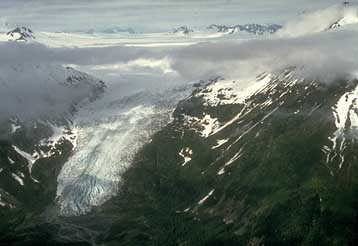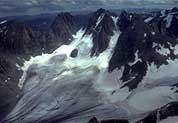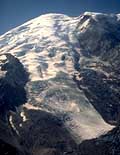
Exit Glacier, Kenai Fjords National Park, Alaska.
Mass Balance and Movement of Glaciers

Exit Glacier, Kenai Fjords National Park, Alaska.
Glaciers, such as the Exit Glacier above, move downhill from regions which accumulate more snow in a given year than they lose--called zones of accumulation. As glaciers move down to lower elevations, the increased temperatures cause greater melting; eventually, the glacier reaches the zone of ablation where more snow and ice is lost than accumulates in a given year. In the above photo, the lower part of the Exit Glacier is clearly within this zone as the surrounding mountainside is below the snow line.
The equilibrium line divides the zone of accumulation and zone of accumulation. At the end of the summer, the location of this line is approximately the same as the firn line--a distinct contact on a glacier between clean snow above, and older ice below, exposed by melting.
The surest way to tell that a glacier is moving is to look for crevasses--vertical extension fractures in the ice. These fractures form because the ice is moving. As the glacier goes around a bend or over subsurface topography, parts of it move faster than others. This difference in velocity causes the ice to break.
 Firn Line |
 Crevasses |
 Crevasses |